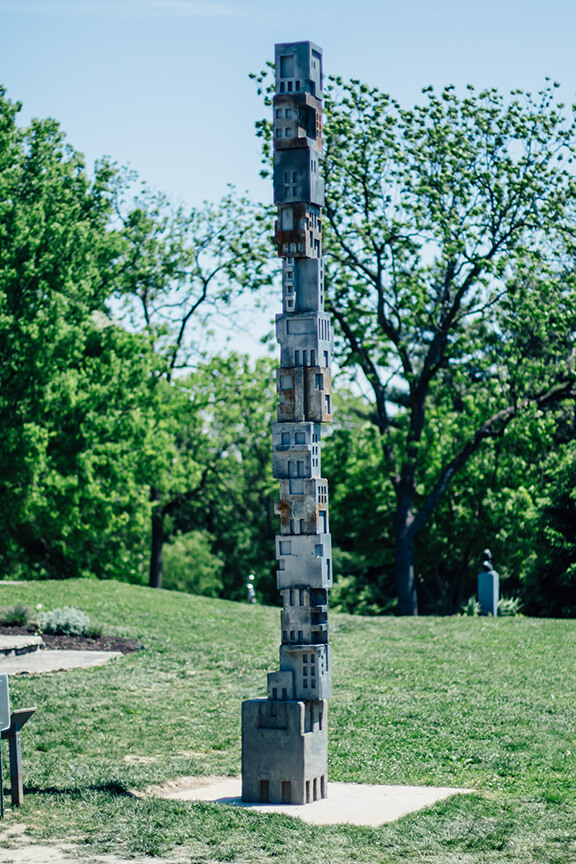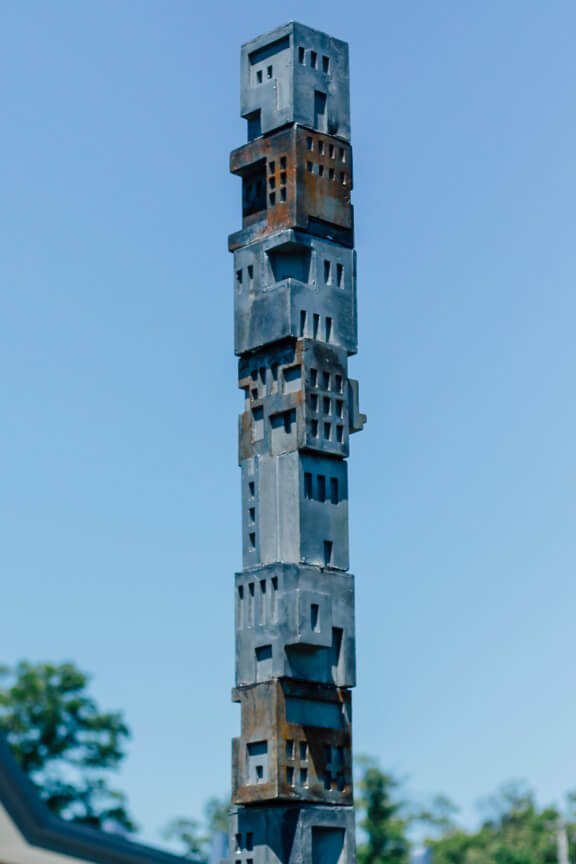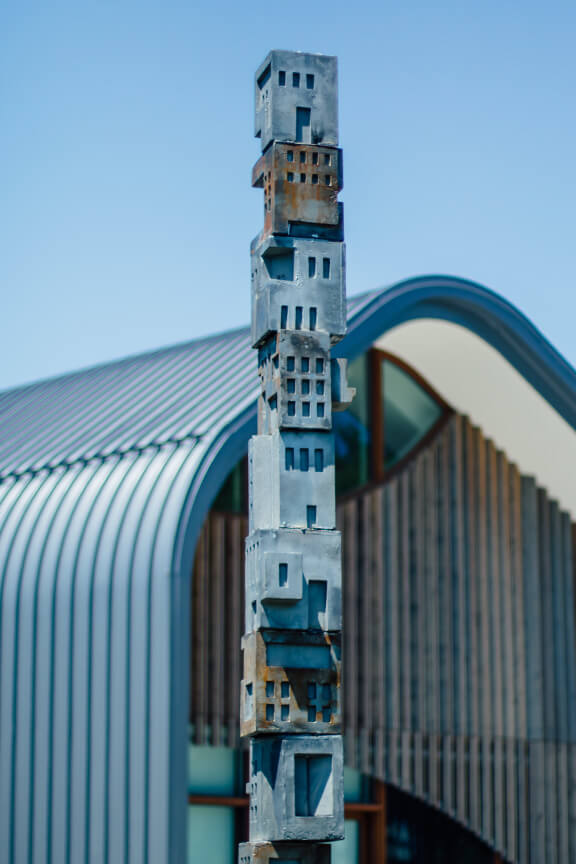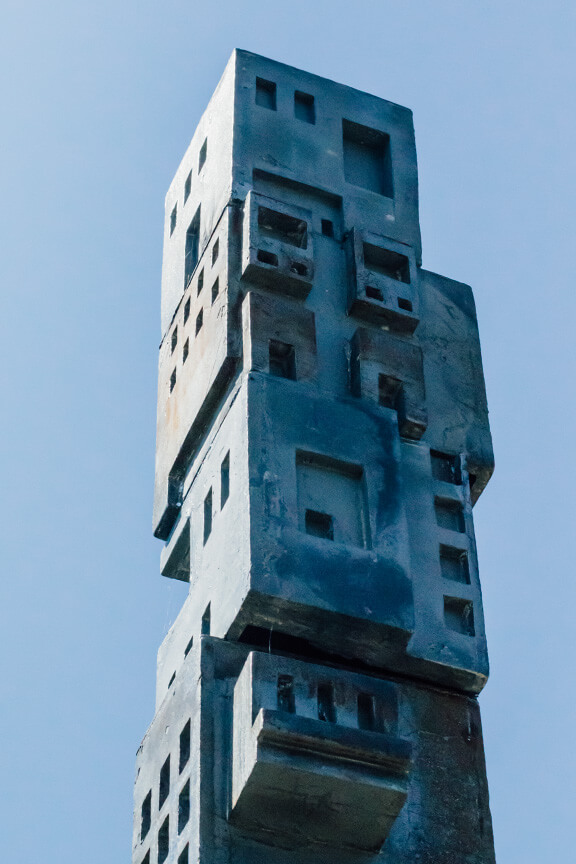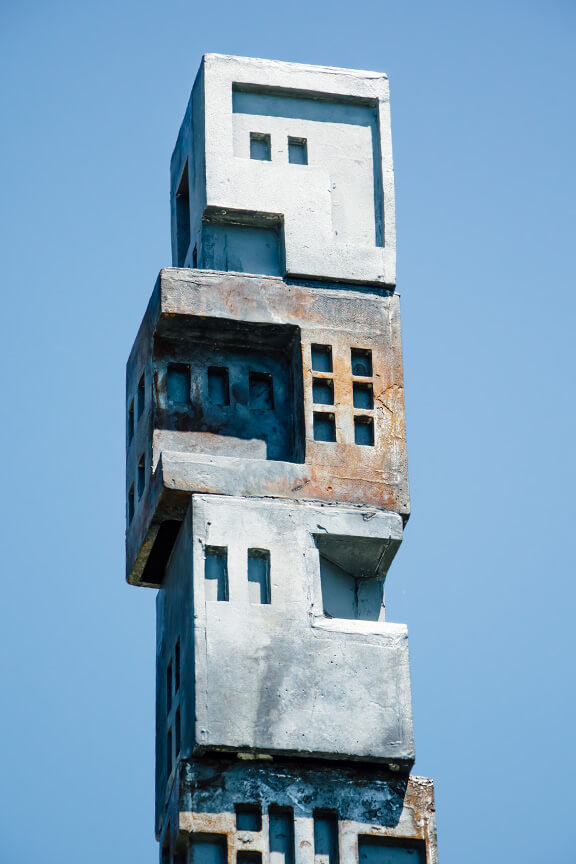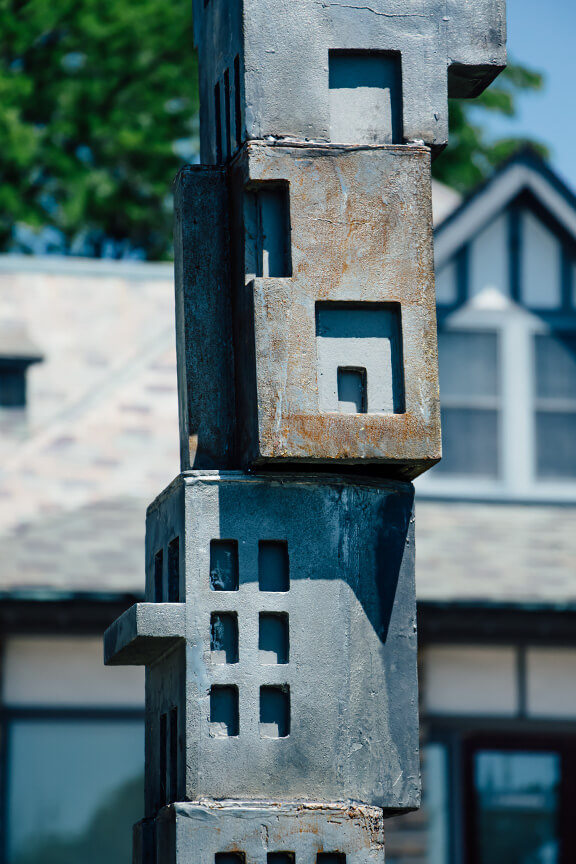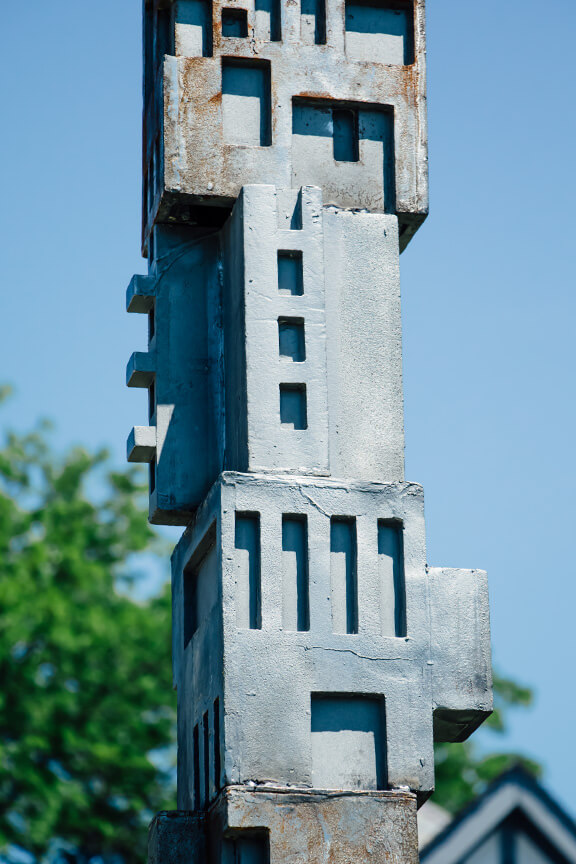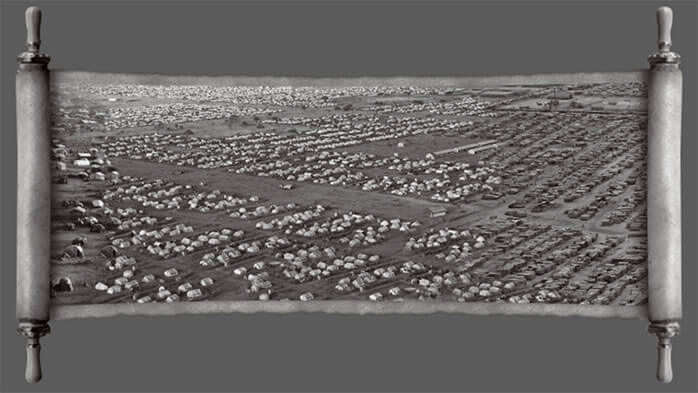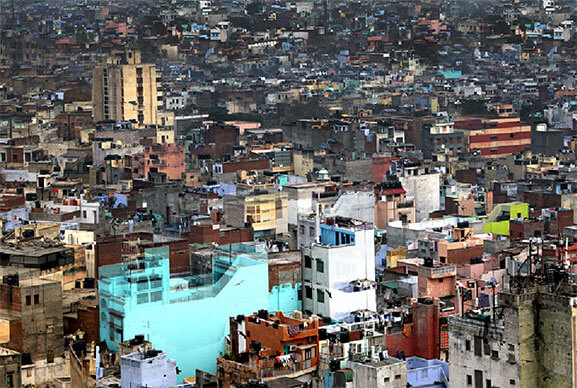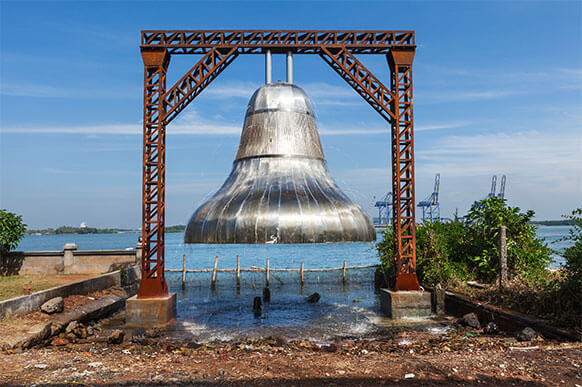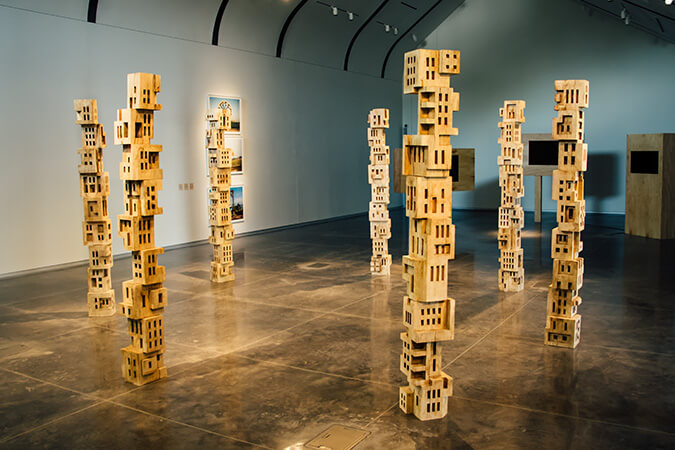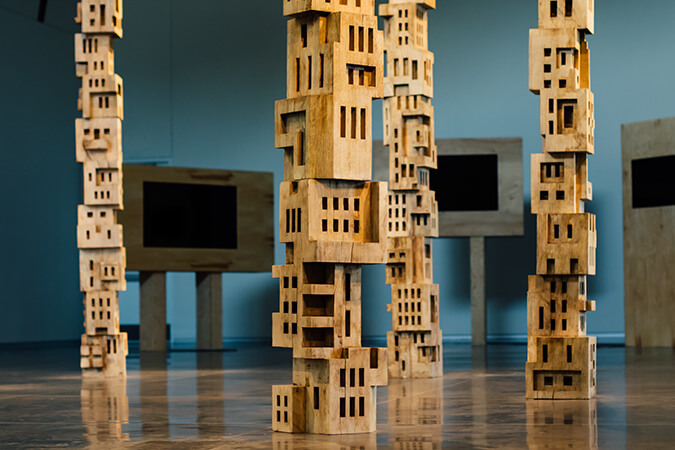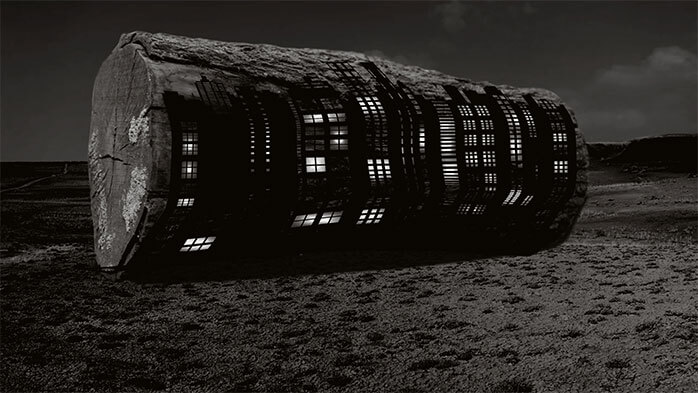-
A CITY & ITS SYMBOLS
Dana Turkovic
Curator of Exhibitions, Laumeier Sculpture Park
“Some of the figures on the poles constitute symbolic reminders of quarrels, murders, debts and other unpleasant occurrences…” Ishmael Reed 1
New Delhi-based artist Gigi Scaria’s practice focuses on remorseless transformation of cityscapes containing millions of lives, unremarkable and unrecorded, recasting their surrounding architectural drift as totemic forms. The sprawl of his home base of New Delhi and the chaotic demolition and displacement throughout impoverished precincts is of special interest. With a dose of satire and a splash of cynicism, his abstracted structures explore time as a changing material through which he analyzes urban architecture and investigates the unstable past, present and future of his location and the fragile impermanence of personal and social space. “Documenting the Indian city today is a tricky affair. They change at such a pace that even as you produce a document it is outdated. Every day there are reports of plans to replace the nearly new with the new and destroy arrangements that have served a diverse population.”2 Familiar with this cultural phenomena, Scaria’s work is also focused on “social mapping,” be it territorial, cultural or environmental, and of the hierarchies and systems of our global communities, a number of which he ties directly to his research about St. Louis, informing the development and selection of works for the exhibition Time.
-
A CITY & ITS SYMBOLS
Dana Turkovic
Curator of Exhibitions, Laumeier Sculpture Park
page #2
Scaria’s exhibition is the second installment of our New Territories: BRICS curatorial program, which focuses on working with artists from areas of the world experiencing rapid economic and industrial development.3 Scaria validates this growth through his observation of New Delhi and synthesizes a number of media for the exhibition, including a photographic triptych, two films, a large indoor sculpture and a new outdoor commission. Each work also draws on totemic themes, continuing his inquiry regarding “time” and community collapse by cross-pollinating the disappearing architecture and symbols from New Delhi with Missouri’s regional history, using the formal organization of the Woodhenge at Cahokia Mounds State Historic Site.
Inspired by a site visit to Cahokia two years ago, Scaria now creates two sculptural works that refer directly to the speculative theories about the collapse of the Mississippian civilization that was abandoned by the mid-13th century. Scaria surveys various icons of deindustrialized landscapes and the comparatively new Indian trend toward suburban sprawl. Laumeier’s location in Sunset Hills, adjacent to the quintessentially model American suburban strongholds of Kirkwood and Crestwood, brings to light the same “happening” in New Delhi.4 The physical erasure of the remnants of the pre-historic, archaeologically distinct community around Cahokia is comparable to the destruction of areas in New Delhi. Obsolescence meets the grinder of modernity. Industrial-scale developments uproot old communities with a long folk history, destroying the “unaesthetic” architecture associated with them. It is this action that becomes the subject and object in Scaria’s hands. “Resistance to the idea of an unknown part of the human psyche,” said Carl Jung,” the individual’s psyche is far from being safely synthesized; on the contrary, it threatens to fragment only too easily under the onslaught of unchecked emotions... We too can become dissociated and lose our identity.”5 If anything, New Delhi’s identity is that of a mortar and pestle grinding the inhabitants into a fine modern paste.
-
A CITY & ITS SYMBOLS
Dana Turkovic
Curator of Exhibitions, Laumeier Sculpture Park
page #3
The historian Lalit Batra laments, “By the time the age of liberalization dawned, even this attempt to deal with the problem was abandoned and was replaced by the concepts of legal and aesthetic criteria.”6 Erasure was placed at a premium as “slums that were illegal and certainly not beautiful could have no place in such a vision. And so began the policy of slum removal and relocation outside the city.” He estimates that between 1998 and 2010, an estimated 100,000 poor people were displaced in the city and relocated haphazardly.
Both the indoor gallery works and outdoor sculpture in the exhibition are inspired by and built upon the similarities of and impetus for the migration shift and community collapse in both our locations, respectively. Woodhenge, 2016, is constructed using seven, ten-foot poles in a circular arrangement, mimicking the formal shape of the Woodhenge at Cahokia. The poles are made up of maquettes of disappearing Delhi domestic spaces, meticulously carved in wood and stacked on top of each other. Cahokia’s site manager, William Iseminger, writes in reference to Woodhenge: “There was symbolism to the circle, representing the cycles of life and the seasons. Indian peoples look at time as cyclical, whereas today we look at it from a more linear perspective. The circle also represents Earth, as seen in much of the Mississippian iconography, especially the circle and cross motif, with the cross representing the four cardinal directions, the four winds or four quarters of the earth.”7 Scaria’s version both vertically maps the reckless civic decisions and illustrates the beauty in simplistic urban domestic habitats.
Extending this same conceptual framework outside into the landscape outside at Laumeier, Woodhenge, 2016, is a towering work using the same architectural motif to create a 16-foot stainless steel totem. For this work, Scaria chose to use a more permanent material to illustrate these ideas—but one that also contrasts with the unaesthetic understanding of these structures. Both of these totemic sculptures stand as a monument to the building of a civilization past and as an illustration of historic and contemporary social and cultural shifts.
-
A CITY & ITS SYMBOLS
Dana Turkovic
Curator of Exhibitions, Laumeier Sculpture Park
page #4
Also included in Time are two recent films by Scaria that highlight the activity of habitation. Both use the movement that video provides to amplify the gestures of expansion and conquest. Shadow of the Ancestors, 2015, is set in a vast and deserted landscape focusing on a large decaying log. In time, the tree trunk casts a growing cityscape in its shadow. Eventually, the big stump rolls back and forth, catches its shadow of high-rise living and presents its imprint of a living landscape of identical apartment blocks. The work highlights Scaria’s preoccupation with mobility and human displacement at the expense of and disregard for the history and the manner in which it can dissipate landscapes at whim. His video Expanded, 2015, uses the same architectural motif common in his other work; the film literally scrolls through an overbuilt landscape of temporary housing as it chronologically unfurls archival images of refugee camps from diverse locations and different times in our history. Stitched together in order to make it look like a single landscape, the scroll has both religious and historical connotations. The work deals with migration and what seems like an infinite stretch of the past and future of an unsettled human condition. Expanded also focuses on temporary structures, the design of habitat and the architecture of basic needs.
-
A CITY & ITS SYMBOLS
Dana Turkovic
Curator of Exhibitions, Laumeier Sculpture Park
page #5
The three photographs included in the exhibition document the artist’s mobile, monumental public sculptural work, each piece rolled into place to provide commentary on the context of its surroundings. In the sculpture Someone Left a Horse on the Shore, 2007, Scaria presents us with a mobile city in the shape of a Trojan horse. Wheel, 2009, was constructed to function as a Ferris wheel of cookie-cutter condos targeted for sale to the growing middle-class, a repetitive amusement ride that reminds us of a history lost in the ceaseless destruction for temporary modernity. Chronicle of the Shores Foretold, 2014, is part of a photo series documenting the performance that is the fabrication and installation of a large-scale public work made for the Kochi Biennale in 2014 signifying the passage of time and experience of religion in the coastal region. In the piece, a 2.5-ton stainless-steel bell stands 13 feet tall at the small dock. It functions as a fountain, with Arabian sea water spilling through its many drilled holes. The sculpture was lifted into place by a group of mappila khalasis 8, who are traditional dockyard workers. Their act, without their knowledge, was part of an orchestrated performance, an homage to the modern-day khalasis who continue to perform feats of lifting, now considered the domain of machines.
Delivered with a sense of humor and deference using a variety of media, Scaria’s approach to the issues that both locations face is not a detached ironic smirk. The body of work in Time suggests that neither money nor machines really create, and that the getting and spending of everyday life diminishes our collective power. When referring to a distant past, as in the case of the Cahokia civilization, or an evolving present, as in the case of suburban St. Louis or New Delhi, indifference would be defeatist. This collection of artwork is a reminder that there are things left for us to say.
Dana Turkovic
Curator of Exhibitions

